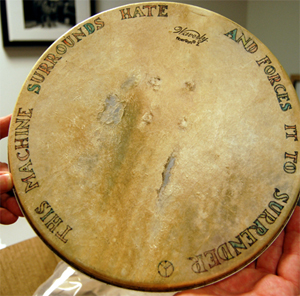This isn’t a proper obituary of Pete Seeger. If that’s what you want, please read Popdose founder Jeff Giles’ beautifully written retrospective over at Ultimate Classic Rock. Instead, I wanted to write a little more personal about my own history with his music.
 ”This machine surrounds hate and forces it to surrender”
”This machine surrounds hate and forces it to surrender”
Those words were printed on Pete Seeger’s five-string banjo. It’s based on the saying famously emblazoned on Woody Guthrie’s guitar, ”This machine kills fascists,” but it’s even more remarkable. It softens Woody’s tone — killing, after all, was anathema to the peace-loving Seeger — while taking aim at something broader, a concept rather than a group that was a relatively easy target.
I grew up hating Pete Seeger. My mother had a lot of those Weavers and Kingston Trio records, and I can remember hearing them, usually on Friday evenings as she got ready for synagogue. It was the worst. At least when she listened to opera I could make fun of the over-the-top singing. But this was so bland that it was intolerable. And why should I care about people singing about striking coal miners or Charlie of the Goddamned MTA 25-30 years earlier when I had plenty of modern music on the radio, without a stupid banjo to be found? Here’s a perfect example, from 1951:
Even though I knew ”Tzena” through Hebrew school, it made no sense to have these undeniably WASPy voices singing about dancing a Hora. I was never the most observant Jew, but I think I now understand how many African Americans felt when white people started singing blues. And when tied to this visual — the formal dress, the earnestness towards the material mixed with show-biz smiles, Lee Hays’ lecture midway through — that I first saw a few years ago, it’s an embodiment of everything Christopher Guest was satirizing with the Folksmen in A Mighty Wind.
As I learned more about rock n’ roll, Pete Seeger became even more polarizing because of the 1965 Newport Folk Festival. He long maintained that his rant about wanting to chop the power cables with an axe during Bob Dylan’s set was misunderstood — that it was due to the poor sound quality rather than his anger at Dylan going electric. But we still don’t know if this was true or merely Seeger’s attempt at revisionism once he realized he was on the wrong side of history. Regardless, it seemed that there were two ways to travel: you could either ride the rails with Seeger and the hoboes or fly down Highway 61 with Dylan. For me, the choice was easy.
I don’t know when my mind changed. There wasn’t a singular moment when it all clicked. I guess that, as I grew and learned about the things in our country’s history that was important to me, I seemed to be aligned with Pete Seeger. Civil rights? Check. Anti-war? Check. Environmentalism? Check. Social justice? Check. By the time Bruce Springsteen released We Shall Overcome: The Seeger Sessions in 2006, I was in much better position to appreciate all those songs I had shunned as a kid.
Not only that, but my mother caught some of Springsteen’s concert from St. Luke’s Old Street Church in London on that tour on PBS’ Great Performances. With that material in that format, she told me that she could, 21 years after she was unwillingly and near-continuously exposed to Springsteen’s music, finally understand what I see in him.
”This machine surrounds hate and forces it to surrender”
Go back to that video of the Weavers I embedded above. As stiffly as it’s presented, Seeger clearly stands out. He carries the other three, not just with his banjo-picking, but with his ability to connect. A couple of years later, they would disband as a result of Red Scare blacklisting, with Seeger and Hays called before the House Un-American Activities Committee in 1955. They reunited in time to help kickstart the folk boom of the late-’50s, but Seeger left in 1958 over a dispute about doing a cigarette commercial. Even if he hadn’t gone solo, he couldn’t have been held back for much longer.
Here’s another video I love. Seeger singing “Worried Man Blues” on Johnny Cash’s variety show in 1970, a few years after the blacklist had effectively ended. Those 15 years of having to stay one step ahead of right-wing protesters would have felled lesser men, but as you can see here, it strengthened him.
This is how we would view Pete Seeger for the remainder of his life — fierce and unwavering in his convictions but always able to draw us in, rather than push us away, with the sheer force of his charisma and that light in his eyes. America still hasn’t entirely come around to his way of thinking, and his work may never be done, but in the last 20 years or so of his life, the world had changed enough for him to be recognized as the global treasure that he was.
”This machine surrounds hate and forces it to surrender”
I had known a little about his testimony in front of the House Un-American Activities Committee in 1955, mainly through the PBS American Masters documentary, The Power of Song, that aired in 2008. But until yesterday (Jan. 28), I had never read the transcript. If not for the fact that so much was at stake, parts of it would be funny. Seeger seems to be practically toying with the Congressmen who are completely out of their depth as Seeger refuses to answer questions about his associations, not by invoking the Fifth Amendment, but by his First Amendment rights. It’s a chilling read and a new glance into something that was consigned to history books by the time I was born. I’ve excerpted some of the most fascinating moments, which you can find by clicking on the next page.





Comments